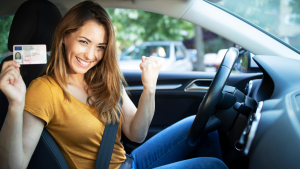During your driving test, the examiner will ask you to carry out one parking manoeuvre, whether that’s parallel parking, bay parking, or pulling up on the right-hand side of the road and
reversing. You won’t know which one you’ll be asked to perform, so it’s important to feel confident and prepared with all of them before your test. At Wimbledon Driving School, we offer driving lessons in Sutton and across the rest of London, supporting learners with passing their test. In this post, we’ll explain the parking techniques that you might be tested on during your driving team and how to tackle each one effectively.
What to Expect from the Parking Section of Your Driving Test
Learners are asked to demonstrate a parking manoeuvre as part of their driving test; however, they won’t know which one has been chosen until they are asked. The examiner will choose one of the three manoeuvres that you have practised during lessons, so it’s vital to be prepared for any of the three they could ask for. You might be asked to perform the manoeuvre either at the test centre at the beginning or end of your test, or during the test route.
The manoeuvre is assessed on control, accuracy, and safety, including how well you observe the surroundings and respond to other road users. Demonstrating good mirror checks, smooth steering, and proper positioning will help to complete the manoeuvre confidently and safely.
Below, we explain each of the three manoeuvres and what they entail:
Parallel Parking
Parallel parking involves reversing into a space behind a parked car, usually on the left-hand side of the road. An examiner will ask you to pull up alongside the car and then reverse into the space, stopping within two car lengths of the vehicle behind. This manoeuvre is all about precision and control. You’ll need to steer smoothly, monitor mirrors, and make sure the final position is close to the kerb without touching it.
To pass, you’ll need to keep good observation throughout, checking mirrors and blind spots and pausing if any vehicles or pedestrians approach. The key is to show awareness, accuracy, and safe handling of the car. You may fail if you mount the pavement, end up too far from the kerb, swing out too wide, or forget to carry out effective observations.
Bay Parking (Reverse or Forward)
Bay parking can either be done by reversing into a parking bay or driving forward into one and reversing out, the examiner will specify which. This manoeuvre is usually performed in the test centre car park. For reverse bay parking, you’ll need to line the car up correctly before reversing slowly and accurately into the bay between two lines. For forward bay parking, the test also assesses how safely you reverse out of the bay when leaving.
During this manoeuvre, the examiner will be looking for good all-round observation, effective use of mirrors, and accurate car positioning. You should avoid crossing the bay lines or needing to readjust excessively. A serious fault can be given for poor control, lack of observation (particularly when reversing out), or ending up parked too far over a line.
Pulling Up on the Right and Reversing
In this manoeuvre, you’ll be asked to pull up on the right-hand side of the road, reverse for around two car lengths, and then rejoin the traffic safely. Although it’s not a common everyday task for many drivers, it tests your ability to carry out basic reversing, positioning, and safely pulling out into moving traffic. Make sure you choose a safe spot to stop and carry out all necessary observations before and during the reverse.
To pass this section, you must show clear awareness of any oncoming traffic and use mirrors and blind spot checks when pulling away. You’ll need to keep the car parallel with the kerb and reverse slowly while looking over your shoulder. You could fail if you forget to check your surroundings, reverse too far, or make the car veer away from the kerb.
Tips for Performing Manoeuvres with Confidence
Parking manoeuvres can be one of the more nerve-wracking parts of the driving test, but with the right techniques, they can be managed with ease. Confidence comes from practice, staying calm, and knowing exactly what the examiner is looking for. Here are some practical tips to help learner drivers feel more in control and perform each manoeuvre to the best of their ability:
- Practise Regularly and Vary the Conditions – The more you practise each manoeuvre, the more natural they will feel. Try to complete each one in different settings, quiet roads, busier areas, and different times of day, to help build flexibility and confidence. This repetition develops muscle memory and helps you react calmly in real test conditions.
- Take Your Time – There’s no need to hurry through a manoeuvre during your test. The examiner is looking for control, safety, and observation, not speed. Staying calm and taking your time allows you to adjust properly and stay focused on completing the manoeuvre accurately.
- Use Reference Points to Help Positioning – Using reference points like road markings, kerbs, or parts of your car can help position yourself more precisely. These visual cues make it easier to judge distances and angles during the manoeuvre. Your instructor can help you find and memorise useful reference points.
Driving Lessons in Sutton with Wimbledon Driving School
If you’re based in Sutton and looking for driving lessons at a reputable school, welcome to Wimbledon Driving School. We offer driving lessons all across London, including in Sutton, with a wide range of lesson options to suit different needs. Our lessons are taught by a team of highly experienced and skilled driving instructors who are here to make learning to drive easy and enjoyable. We have a range of lessons to choose from; including single lessons, Pass Plus courses, refresher lessons and more. Contact us today to learn more about our driving lessons in Sutton, or book lessons online.





